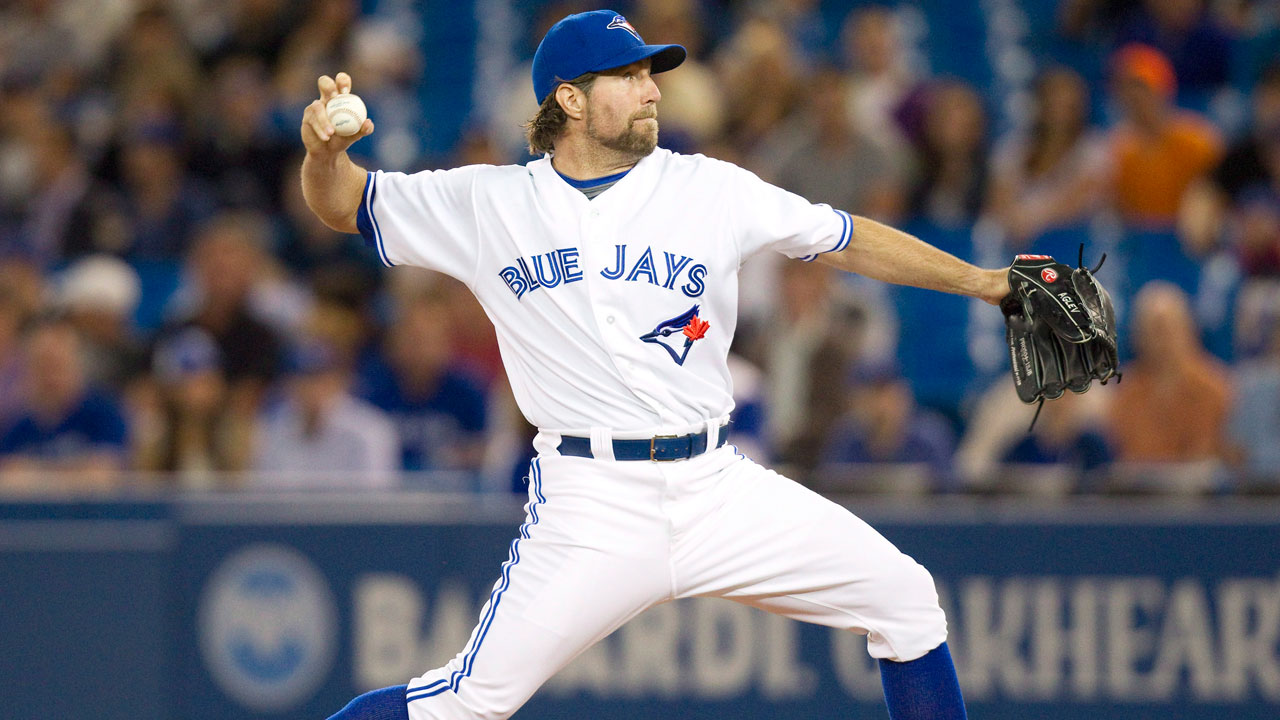TORONTO – There are times when R.A. Dickey almost seems to get angry on the mound, channeling what looks like a sudden surge of aggression into his pitches, at times to great effect.
Does pitching mad actually work for him?
“More than that, it’s a matter of trying to figure out which type of knuckleball is going to be successful for that particular climate, that particular club … it’s trying to figure out quickly which one they’re going to respond less favourably to,” the Toronto Blue Jays right-hander said Tuesday, a day after he allowed two runs in five innings of work but for the second straight start left the bases loaded.
“As you saw [Monday night against the Minnesota Twins], I had probably two dozen knuckleballs that were 80 or above, and the string of hitters where I was retiring [11] in a row, that was the answer. I don’t know if it’s angry, it’s just trying to get it right, trying to figure it out, and testing different hypotheses during a game to see which one is going to work.”
Of late, the in-game adaptation process has taken Dickey longer than he’d like, and one takeaway from his outing Monday was of the potential benefits from coming out of the gates more aggressively.
To that end he’s been using his fastball more often this season – up to 14.3 percent from 11.9 percent last year – and his knuckleball has averaged 76.5 mph, up about one mph from last year. For context, his fastball usage is in line with his Cy Young year in 2012, although the velocity on his heater is down about one mph from the 83.4 it sat at in 2012, while his knuckleball is down a bit from 77.1 that year.
The reason for the re-adjustment is “because I’ve had a lot of high-pitch games,” Dickey explained.
“I had a 31-pitch first inning [Monday] against the [Twins], I had a 30-pitch first inning against the Royals, and I need to get to trying to induce contact earlier in counts,” he continued. “In that regard, it’s been something I’ve consciously tried to do. Minnesota is a team that leads the league in pitches taken, so whenever you have a club like that you want to try and get ahead of guys.”
Walks weren’t a big problem for him Monday, but they have been this season, as his rate of 4.1 per nine innings, by far his highest since his early days as a knuckleballer in 2008 and ’09.
There are other concerns, too, such as his inability to get through the sixth in his last three starts, and he’s left with two runners on in nine of his 14 starts. The 39-year-old also fought through what he called a “cranky body day” two starts ago in Detroit, although that improved Monday.
“I’m feeling good and I’m going to hit a stretch where it’s all going to kind of even out,” he said. “I’m just going to grind it out until that comes.”
That’s part of the burden of being a knuckleballer, which is why Dickey is keeping an eye on Frank Viola III, who threw four shutout innings, allowing three hits and four walks with four strikeouts, in his debut with the single-A Lansing Lugnuts.
“A knuckleballer’s line,” Dickey said with fondness.
Viola spent two months in Dickey’s hometown of Nashville over the winter and the two played catch together regularly. They first met while Dickey was with the Mets, and Viola asked him to come and watch him.
“At that point I wasn’t as optimistic as I have become because he just wasn’t in the same place,” said Dickey. “But the second time I saw him was when he came to Nashville to throw with me and we played catch together, and I was able to see first-hand that I thought he could repeat a delivery mechanically, and he could take spin off the baseball. And if you can do those two things, you’ve got a shot.”
Once the physical side gets settled, the mental side of living with the pitch becomes the primary challenge.
Dickey still lives with those inherent frustrations.
“The results can make you angry,” he said. “I don’t know in my career if I’ve ever given up back-to-back home runs to lead off a game [as he did Monday to Danny Santana and Brian Dozier]. When you start 2-0 and put your club in a hole, it’s going to make you angry, but it wasn’t until three innings after that where I really figured out the right speed.
“There was a lot of humidity in the air and so the slow one just wasn’t going to move as much. I had to create my own air resistance to the baseball, thus the higher velocities were moving more. … [Monday] night was just an outing where I wish I would have gone to the hard one earlier.”
On Saturday in Baltimore, he’ll get the chance to adjust.


